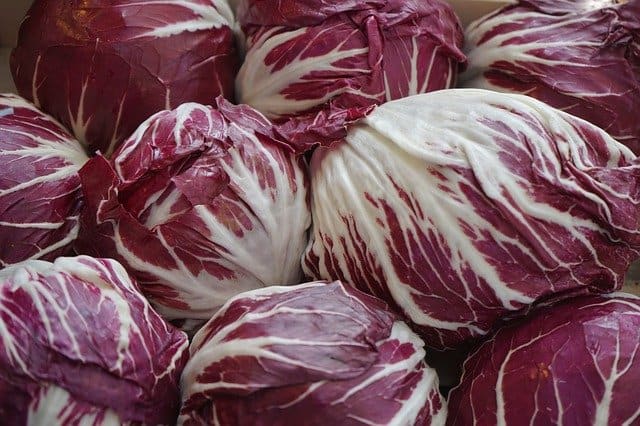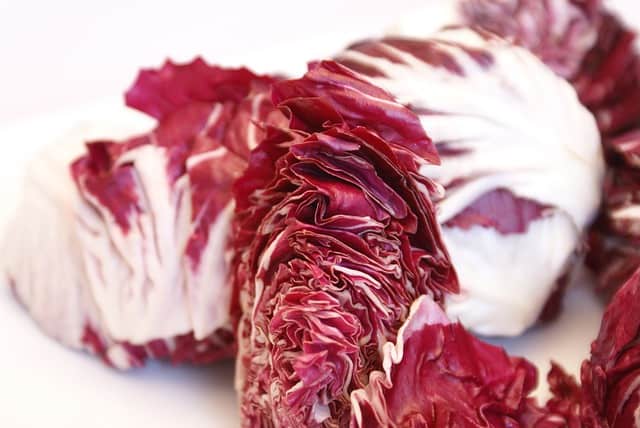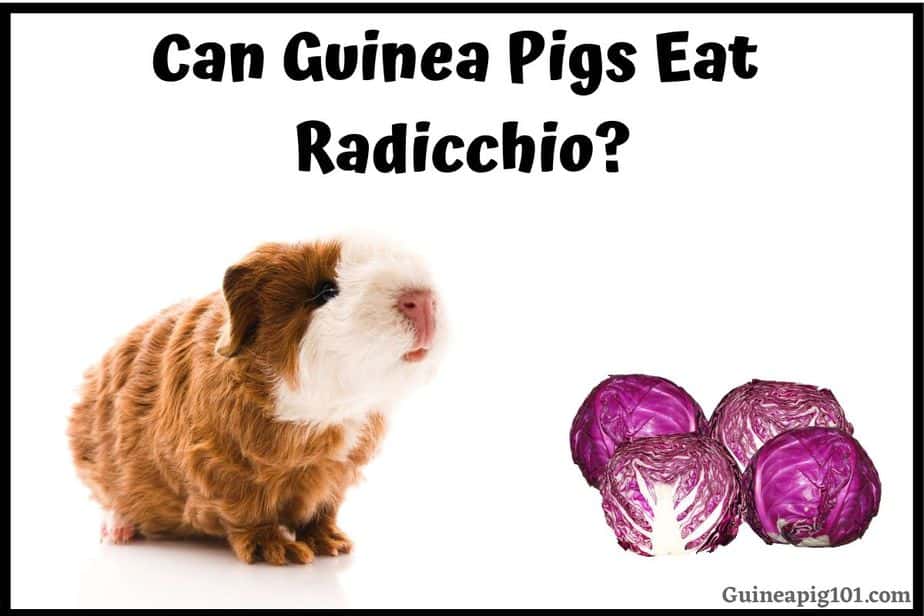Radicchio looks very similar to red cabbage and is a rich source of vitamins, minerals, and dietary fiber. It has numerous benefits for human beings as it helps in weight loss, reduces cholesterol, controls blood sugar, and protects against many other illnesses.
But can guinea pigs eat radicchio? Is it safe for them? I decided to do some research and here is what I have learned.
Guinea pigs can eat radicchio as it is an excellent source of dietary fiber, vitamins, and minerals. However, we cannot serve it daily as it is acidic and can lead to diarrhea and bloating in guinea pigs. You can feed a small amount 2-3 times a week.
Radicchio is also rich in sodium that is terrible for our guinea pigs especially if fed daily.
So, now you know that guinea pigs can eat radicchio, you must we wondering how much radicchio should you feed and what other vegetables should you mix it with.
But before knowing that, let us learn about some nutrients in radicchio so that we can balance our guinea pig’s diet.
Nutrition in radicchio?
| Nutrients | Amount |
|---|---|
| Vitamin C | 8 mg/ 100 g |
| Vitamin K | 255.2 µg/100 g |
| Vitamin A | 1 µg/ 100 g |
| Magnesium | 13 µg/ 100 g |
| Calcium | 19 mg/ 100 g |
| Phosphorous | 40 mg/ 100 g |
| Potassium | 302 mg/ 100 g |
| Fiber | 0.9 g/ 100 g |
| Sugar | 0.6 g/ 100 g |
| Protein | 1.43 g/ 100 g |
| Carbs | 4.48 g/ 100 g |
| Sodium | 22 mg/ 100 g |
| Fat | 0.25 g/ 100 g |
| Water | 93.14 g/ 100 g |
Here is a list of some essential nutrients present in radicchio:
- Vitamin K: Radicchio contains a good amount of Vitamin K, which plays a massive role in preventing blood clots and protein for bones.
- Consuming Vitamin K also minimizes the chance of fracture in older guinea pigs with weak bones. It is also very effective in counteracting overdose of blood. Like any other vitamin, it is not used as a dietary supplement.
- According to studies, Vitamin K deficiencies are rare in adults and are mostly found in newborn babies.
- Magnesium: Radicchio also contains a decent amount of magnesium which provides numerous benefits to the body as it helps to fight with depression.
- It also helps to regulate blood pressure and protect the body from type 2 diabetes
- Sodium: Radicchio also holds a good amount of sodium, which provides several benefits to the body.
- It reduces the chances of heart attack, helps to maintain blood pressure, helps prevent kidney damage, and protects against many other diseases.
- Potassium: Radicchio also holds a good amount of potassium, which is very important macrominerals needed by our body, helping to minimize blood and water retention.
- Potassium also protects from kidney stones and several other diseases.
- Lacking potassium can lead to many problems like weakness and constipation. But excessive intake of potassium can lead to hyperkalemia.
Is radicchio safe for guinea pigs?

Yes, radicchio is safe for our guinea pigs. There are many benefits our guinea pigs can derive from the radicchio.
Some of the common benefits of feeding radicchio to our guinea pig are:
- Hydrates the body: Radicchio has a high water content, which gives several benefits to our guinea pigs as it helps to stay hydrated and protect against several other diseases.
- According to studies, guinea pigs require at least 80-100mls of water per day. Radicchio can fulfill the water requirement of our guinea pig.
- Fiber Content: Radicchio also holds a small amount of dietary fiber, which provides many benefits to our guinea pig as it helps in digestion and also helps to prevent many stomach issues.
- Calcium-phosphorus ratio: One of the most important benefits of radicchio is that it has a low calcium-phosphorus ratio, which helps lower the calcium consumption when served with high ratio foods. The ideal ratio of guinea pig food is 2:1.
- Rich in antioxidants: Radicchio also contains a good amount of lutein and zeaxanthin, which are also known as antioxidants which protect cells against free radicals and also play a very important role in preventing heart diseases.
- Antioxidants are very much required by our guinea pig to stay healthy.
Is radicchio good for guinea pigs?
Yes, radicchio is good for our guinea pig if served in a moderate quantity as it contains a decent amount of sodium, phosphorous, fat, and acidic content. Excessive serving can lead to significant health issues.
Let us discuss some disadvantages of serving excessive radicchio to our guinea pig.
- Lack of vitamin c: Radicchio lacks Vitamin C, which is the most essential nutrient for our guinea pigs. That is why we cannot serve radicchio daily to our guinea pig.
- Guinea pigs require at least 90mg of Vitamin C daily as they cannot produce Vitamin C on their own.
- Phosphorus content: Radicchio also contains a small amount of phosphorus which, if consumed in an excessive quantity, can affect the growth and survival of our guinea pig.
- If our guinea pig intakes a high phosphorus diet, it many develop deposits of calcium phosphate, which can affect their growth and survival.
- Sodium content: Radicchio contains a small amount of sodium which, if not taken in a moderate quantity, can cause severe damage to our guinea pigs. Guinea pigs have a susceptible digestive system that can not digest sodium well. Thus, moderate feeding is recommended.
- Urinary Complications: Radicchio also holds a small amount of calcium which, if consumed in excessive quantities, can result in too many urinary complications to our guinea pigs like urinary stones, pain, or infections in the urinary tract.
- With growing age, the need for calcium decreases in our guinea pigs. Calcium is required in a young age for the formation of bones.
How often can guinea pigs have radicchio?

Guinea pigs can have radicchio two to three times a week in a moderate quantity.
As it lacks in Vitamin C and also contains a decent amount of sodium, phosphorus, fat, etc in it, we should not serve it in large quantities.
Overfeeding of radicchio can lead to significant health issues like urinary infection, diarrhea, etc.
How much radicchio can guinea pigs eat?
Guinea pigs can eat 1-2 small leaves of radicchio at a time. Don’t serve more than that as moderation is a key to a healthy life.
As radicchio lacks in Vitamin C, it cannot be served as a regular meal to our guinea pigs. We must mix it with other high Vitamin C vegetables to create a well-balanced diet for our guinea pigs.
I usually mix radicchio with other Vitamin C rich vegetables like bell peppers, chards, kale, arugula, spinach, etc. to balance out their diet.
You can make a healthy mix of vegetables and serve it in a bowl.
Can guinea pigs eat radicchio lettuce every day?

No, we cannot serve radicchio Lettuce every day as it contains a decent amount of sodium and has an acidic content. Radicchio lettuce can only be served occasionally.
As radicchio does not contain sufficient nutritional value, it can only be served as a treat and should not be added to their regular meal. Their regular meal must consist of fresh hay and veggies.
Can guinea pigs eat radicchio stalks?
No, guinea pigs should not be served with stalks of lettuce, as it can be a choking hazard for them. We must try to avoid it as much as possible.
It would be best if you remembered that guinea pig’s regular diet must consist of fresh hay and veggies.
You can provide them with other safe tree branches like apple, willow, birch, etc.
Can guinea pigs eat radicchio leaves?
Yes, guinea pigs can eat radicchio leaves but not more than two times a week.
Make sure you wash the leaves properly before serving to remove any pesticides or chemicals attached to it.
Can guinea pigs eat cooked radicchio lettuce?

No, Guinea pigs cannot eat cooked radicchio lettuce at all.
Serving cooked radicchio lettuce can be a terrible idea as it contains a good amount of sodium and oil, leading to significant health issues for our guinea pig.
It would be best if you always remember that guinea pig’s regular diet must consist of fresh hay and veggies.
How to prepare radicchio lettuce for your guinea pigs?
Here is an easy to follow steps to prepare radicchio lettuce for your guinea pigs.
- The first step is to select a radicchio lettuce for your guinea pig. It must be dark green and should not be brown.
- The second step is to pick one or two leaves and wash them properly to ensure that there is no dirt on the surface.
- The third step is to remove the stalks away as it can be a choking hazard for them. After removing the stalks you can chop the leaves into smaller pieces so that your guinea pig does not face any problem while having its meal.
- And finally, the last step is to serve the meal to your guinea pig. You should serve it with some veggies to balance the nutritional requirement of your guinea pigs.
- Remember to remove any uneaten vegetables from the cage. Uneaten fruits and vegetables are often the hotspots for bacterial bloom. It also attracts flies and rats towards your guinea pigs.
Pro tip: You can also prepare the vegetable for a few days or a few serving at a time and use proper quality vegetable storage contains for keeping the same fresh and ready.
It works like a charm, especially if you have a busy schedule.
Conclusion: Guinea pigs and Radicchio
- Radicchio is a rich source of Vitamins, minerals, and dietary fiber. It provides numerous benefits to our guinea pig if consumed in a moderate quantity.
- You can serve radicchio two times a week in a moderate quantity as moderation is a key to a healthy life.
- You can serve 1-2 small leaves of radicchio lettuce at a time to your guinea pigs.
- Overfeeding of radicchio can lead to serious health issues as it contains a decent amount of sodium, phosphorus, and natural acid.
- Cooked radicchio lettuce cannot be served to our guinea pig as it contains a good amount of sodium and oil.
- Radicchio must not be included in their regular diet; their regular diet must consist of fresh hay and veggies.
Sources: Everything you need to know about radicchio, Nutrition in radicchio, Diet Composition and Mineral Balance in Guinea Pigs, Dietary Vitamin C, and Vitamin E on Guinea Pig Immune Responses to Mitogens, Vitamin C requirements of the guinea-pig, Is Your Guinea Pig’s Diet Providing the Right Nutrients? Care of Guinea Pigs.
